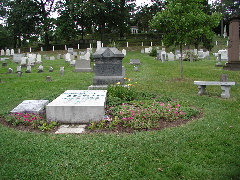timeline of Frederick Douglass
and family
1818. (Exact
date unknown) Frederick Douglass is born as Frederick Augustus
Washington Bailey, a slave at Holme Hill Farm, Talbot County,
Maryland.
His mother, Harriet Bailey, was a field slave from whom he was
separated during his infancy. Douglass only saw his mother four
or five times thereafter and for only a few hours each time. She
had been sold to a man who lived twelve miles from where Douglass
lived, and to see her son required that after her day's work in
the field she walk the twelve miles, visit with him for a short
time during the night, walk the twelve miles back to her home,
and work a second day in the fields without rest. She died when
Douglass was about seven.
Douglass never knew for certain whom his father was. He did know
that his father was white, and he believed he was his master,
Aaron Anthony.
1826. Sent to
live with Hugh Auld family in Baltimore.
1827. Asks Sophia
Auld to teach him his letters. Hugh Auld stops the lessons because
he feels that learning makes slaves discontented and rebellious.
1834. Hired Out
to Edward Covey, a "slave breaker", to break his spirit
and make him accept slavery.
1836. Tries to
escape from slavery, but his plot is discovered.
|
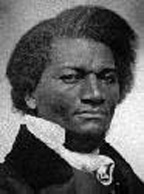
Frederick Douglass
|
1836-38. Works
in Baltimore shipyards as a caulker. Falls in love with Anna
Murray, a free Negro (daughter of slaves).
1838. Douglass
escapes from slavery and goes to New York City. Marries Anna
Murray.
1839. Doughter
Rosetta (1839 - 1906) is born. Frederick subscribes to William
Garrison's The Liberator.
|
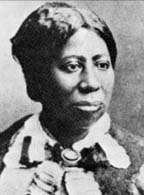
Anna Murray Douglass
|
1840. Son Lewis
Henry (1840 - 1908) is born.
1841. Speaks
at a meeting of the Bristol Anti-Slavery Society, and subsequently,
at the urging of William Lloyd Garrison, Douglass became a lecturer
for the American Anti-Slavery Society and travels widely in the
East and Midwest lecturing against slavery and campaigning for
rights of free Blacks.
1842. Son Frederick
Douglass, Jr. (1842 - 1892) is born.
1843. Organized
by Abner A. Frances, Henry Moxley (see 1832), the Charles L. Reason (the first
Black math professor at a white college), and others, a National
Convention of Colored Men was held in Buffalo to find ways to
end slavery. The keynote speaker, Samuel H. Davis of Buffalo,
called on northern Blacks to take part in the great battle for
our rights in common with other citizens of the United States.
Meeting in Buffalo around the same time was the abolitionist National
Convention of the Liberty Party. However, William Wells Brown
did not trust the Liberty Party, a white man's organization (see
1836).
Frederick Douglass attended both conventions.
He reports:
For nearly a week I spoke every day in this old post office
to audiences increasing in numbers and respectibility til the
[Michigan Avenue] Baptist church was thrown open to me. When
this became too small I went on Sunday into the open park and
addressed an assembly of 4,000 persons. [Goldman]
1844. Son Charles
Remond (1844 - 1920) is born.
1845. Publishes
the first of three autobiographies: The
Narrative of the Life of Frederick Douglass: An American Slave.
To escape recapture following publication, goes to England lecturing
on the American anti-slavery movement throughout the British Isles.
1846. Becomes
legally free when British supporters purchase his freedom from
Hugh Auld, his former master.
1847a. Frederick
and Anna Murray Douglass, attracted by Susan B. Anthony's very
active women's movement, moved their family (8 year old Rosetta,
7 year old Lewis, 5 year old Frederick, and 3 year old Charles)
to Rochester New York. Even their prejudice forced the Douglass'
children to be educated elsewhere.
The presence of Frederick Douglass, a famous
ex-slave who became a prominent abolitionist, publisher and spokesman
against slavery, helped to enhance Rochester's reputation as a
liberal minded city. In fact, Douglass used his own Rochester
home as one of the stops used for fugitive slaves.
1847b. Martin
R. Delany moves from Pittsburgh to Rochester in order to found
with and work with Frederick Douglass and William Cooper Nell
on a new paper, North Star, printed in the basement of
Memorial African Methodist Episcopal Zion church, a flourishing
center for "underground" activities. Some local citizens
were unhappy that their town was the site of a black newspaper,
and the New York Herald urged the citizens of Rochester to dump
Douglass's printing press into Lake Ontario. Gradually, Rochester
came to take pride in the North Star and its bold editor. starting
the North Star marked the end of his dependence on Garrison and
other white abolitionists. The paper allowed him to discover the
problems facing blacks around the country. Douglass had heated
arguments with many of his fellow black activists, but these debates
showed that his people were beginning to involve themselves in
the center of events affecting their position in America. [Rollin]
|
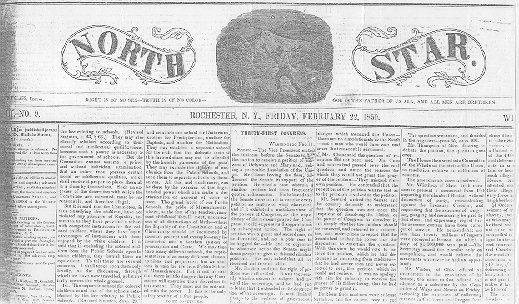
|
|
Once the North Star began to circulate,
Douglass's friends in the abolitionist movement rallied to join
in praising it. However, not everyone was pleased to see another
antislavery paper - especially one edited by an ex-slave. Some
local citizens were unhappy that their town was the site of a
black newspaper, and the New York Herald urged the citizens
of Rochester to dump Douglass's printing press into Lake Ontario.
Gradually, Rochester came to take pride in the North Star
and its bold editor.
The town had a reputation for being pro-abolitionist.
Rochester's women were active in antislavery societies, and through
them Douglass kept in close contact with the leaders in the fight
for women's rights, among them Susan B. Anthony, Lucretia Mott,
and Elizabeth Cady Stanton. Along with the good will of Rochester's
abolitionist and female political activists, Douglass received
encouragement from the local printer's union. The North Star
received a number of glowing reviews, but unfortunately the praises
did not translate into financial success. The cost of producing
a weekly newspaper was high and subscriptions grew slowly. For
a number of years, Douglass was forced to depend on his own savings
and contributions from friends to keep the paper afloat. He was
forced to return to the lecture circuit to raise money for the
paper. During the paper's first year, he was on the road for
six months. In the spring of 1848, he had to mortgage his home.
In the midst of these troubles, a friend from
England arrived to help Douglass with his financial problems.
Julia Griffiths had raised enough money to help launch the paper,
and now she was prepared to fight for its survival. Griffiths
put the North Star's finances in order, and Douglass was
eventually able to regain possession of his home. By 1851, he
would be able to write to his friend, the abolitionist publisher
and politician Gerrit Smith, "The North Star sustains
itself, and partly sustains my large family. It has reached a
living point. Hitherto, the struggle of its life has been to
live. Now it more than lives." Despite the ups and downs,
Douglass's newspaper continued publication as a weekly until
1860 and survived for three more years as a monthly. After 1851,
it would be titled Frederick Douglass' Paper. Douglass's
newspaper symbolized the potential for blacks to achieve whatever
goals they set. The paper provided a forum for black writers
and highlighted the success achieved by prominent black figures
in American society.
The paper survived as a weekly until 1860
and then for three more years as a monthly.
|
1848. Douglass attends the first women's rights convention
at Seneca Falls, NY and advocates the right to vote for women.
While he roamed far beyond his original bounds, his wife, though
hard-working, remained uneducated and politically unambitious.
In England he met Julia Griffiths and brought her home to live
with him in the Rochester family house as a tutor for his children
and for wife Anna in 1848. But his effort with his wife failed
and Anna remained almost totally illiterate until her death.
A scandal erupted when Julia Griffiths began
to serve as Douglass's office and business manager and soon became
his almost constant companion. She arranged his lectures, dealt
with the paper's finances and accompanied him to meetings. People
in Rochester gradually adjusted to the sight of the black leader
and the white woman walking arm in arm down the street.
1849a. Annie
Douglass, Frederick's last child, is born.
1849b. On May
5 Douglass is attacked by gang of toughs when he walks along Battery
in New York City with two British women friends, Julia and Eliza
Griffiths.
1850a. Publishes
an attack on the Compromise of 1850 and the new fugitive-slave
law.
1851a. Changes
the name of North Star to Frederick Douglass' Paper. Helps
three fugitive Maryland slaves escape to Canada as "Station
Master" of the Rochester terminus of the Underground Railroad(read more).
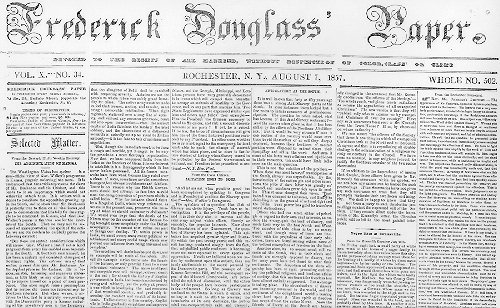
1851b. Julia
Griffiths helped put the 'North Star's' finances in order.
Julia Griffiths was one of six founders of
the Rochester
Ladies' Anti-Slavery and Sewing Society. The "Sewing"
was later dropped. By March, 1852, the Society had grown to nineteen
members, when they held the first of their Festivals, or bazaars.
In these events, held annually for over a decade, the women of
the Society raised money through the sale of items made locally
or contributed by other anti-slavery societies as far away as
Britain, and through gate receipts for lectures by Frederick Douglass,
Gerrit Smith, or other activists held in the Corinthian Hall.
The first Festival was advertised in newspapers as far away as
New York, Philadelphia, and Washington, D.C., and by all accounts,
it was a rousing success, netting over $250. Following on the
heels of this bazaar, the Society intensified their fund raising
efforts, matching success with success. In 1853, Julia Griffiths
edited Autographs for freedom, a collection of antislavery
essays by William Wells and Black mathematician Charles
Reason and others, with facsimile signatures of the contributors,
which sold so well that a second edition was prepared the following
year. In the winter of 1854-55, the Society also sponsored its
first annual lecture series, bringing in renowned speakers. Once
again, the Society found a large and receptive audience for their
message. Colleagues in British antislavery societies provided
an important and regular source of funds through bazaars held
on behalf of the Rochester Society. By the late 1850s, the annual
receipts of the Society surpassed $1,500.
The bulk of the money raised by the Society
was used in the important task of keeping Frederick Douglass'
Paper solvent, but money was also used to help support a school
for freedmen in Kansas and for the publication and distribution
of anti-slavery literature in Kentucky. The Society played a crucial
support role in one stretch of the Underground Railroad, providing
small cash gifts directly to fugitive slaves to aid them on the
last leg of their escape to Canada. The Society's annual reports
for 1855 and 1856 listed 136 fugitives who had passed through
Rochester with the Society's help, and by the following year,
they had begun to develop a connection with veteran "railroad"
engineer, Harriet Tubman.
The pro-slavery pessure and Black and White lover scandal became
too much and in 1855 Julia Griffiths returned to England and got
married
1851c. Douglass
aids three fugitive Maryland slaves, wanted for murdering their
former master when he tried to recapture them in Pennsylvania
in escaping to Canada. The three are among hundreds Douglass helps
flee to freedom as "station master" of the Rochester
terminus of the Underground Railroad.
1852a. Splits
with Garrison over the means to achieve the abolition of slavery.
Chosen vice-presidential candidate at the Liberal Party convention.
Delivers his famous speech, "What to the Slave is the Fourth
of July?" in Corinthian Hall, Rochester, New York.
1852b. Griffiths
decided to spare Douglass further embarrassment by moving out
of his home. She remained his close associate until she left the
United States.
1853. With Frederick
Douglass as a draw, the National Negro Convention (also known
as the Colored National Convention) meets in Rochester.
1855a. Douglass
writes a second autobiography: My Bondage and My Freedom.
1855b. Aware
that Douglass' enemies were using his highly public relationship
with Griffith as negative fodder, Julia Griffith returns home
to England.
|
1855c. Douglass meets Ottilie Assing. Ottilie (1819-1884)
was a German (half-Jew) journalist for the prestigious German
newspaper Morgenblatt für gebildete Leser, who traveled
to Rochester, New York, in 1856 to interview Douglass. Assing
spent the next 22 summers with the Douglass family, working on
articles, the translation project, and tutoring his children.
Anna Douglass, Frederick's wife, was somewhat
older than Frederick and illiterate, was als ill much of the
time. She shared little of her husband's intellect or interests,
and seemed unable to cope with the large household.
Assing, on the other hand, was a passionate
abolitionist, was politically astute, and contributed a great
deal to Douglass' work. The affair was never confined to the
domestic sphere, and it was never a secret. For most of their
26 year friendship, when apart, Frederick and Ottilie weekly
wrote each other. Assing was confident that, upon Anna's death,
Douglass would marry her. Oh, bitter news! He wed another woman
- white, bright and 20 years his junior. Heartbroken and ill
with breast cancer, Assing walked into a park, opened a tiny
vial and swallowed the potassium cyanide within. Still Ottilie
left Frederick Douglass as the sole heir in her will.
|
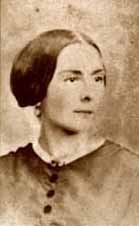
Ottilie Assing
|
[Note. The Douglass's letters to Assing were burned, and only
a handful survive from Assing to Douglass. There is a book by
a professor of American Studies at University of Muenster in Germany: Love
across Color Lines: Ottilie Assing and Frederick Douglass.
By Maria Diedrich. (New York: Hill and Wang, 1999. xxx, 480 pp.
$35.00, isbn 0-8090-1613-3.) ]
1857. The Rochester
public schools desegregate after years of Frederick Douglasses
protestations.
1858. John Brown
stays at the Douglass home in Rochester while developing plans
for encouraging a slave revolt.
1859a. Escapes
to Canada to avoid being arrested as an accomplice in John Brown's
plan to seize Harper's Ferry and sails to England:
Douglass knew and supported John Brown in his assisting escaped
slaves to reach Canada. But when in 1859 Brown told him of the
plan to assault the Harpers Ferry Arsenal and to arm the slaves
for an insurrection, Douglass knew that his friend had gone round
the bend and declined to participate in the raid. Brown's confiscated
papers mentioned the name of Douglass, and a request for his arrest
was issued. This led Douglass to take an immediate unplanned voyage
to Europe, where he met up with Ottilie Assing, and, on the lecture
circuit he acclaimed, from afar, the martyrdom of John Brown.
1859b. Ottilie
Assing, vividly described for a German paper, a demarcation line
that surrounded Douglass's home: "This is the house of FD,
the famous colored orator, who lives in the country close to Rochester
, and American color prejudice is the demon which surrounds this
house like a Chinese wall, beyond which only the most determined
and ardent abolitionists dare to step."
1859c. Eleven-year
old daughter Annie Douglass dies.
1860. Returns
to the United States upon hearing of the death of his, Annie.
Her death had the effect of curtailing Douglass' European speaking
tours.
1861. Calls for
the use of Black troops to fight the Confederacy through the establishment
of Negro regiments in the Union Army.
1863a. Congress
authorized black enlistment in the Union army. The Massachusetts
54th Regimate was the first black unit to be formed, and the governor
of the state asked Frederick Douglass to help in the recruitment.
Douglass agreed and wrote an editorial that was published in the
local newspapers. "Men of Color, to Arms," he urged
blacks to "end in a day the bondage of centuries" and
to earn their equality and show their patriotism by fighting in
the Union cause. His sons Lewis and Charles were among the first
Rochester African Americans to enlist. Douglass visited President
Abraham Lincoln to protest discrimination against Black troops.
1863b. Rosetta
Douglass , daughter of Frederick, returns to Rochester with new
husband Nathaniel Sprague.
1863c. Douglass
visits President Lincoln, protests discrimination against black
troops; visits President Lincoln in White House to plead the case
of the Negro soldiers discriminated against in the Union army;
receives assurance from Lincoln that problem will be given every
consideration; visits secretary of War Stanton and assured that
he will receive a commission in Union Army to Recruit Negro soldiers
in South.
1864. Frederick
Douglass served as an adviser to President Abraham Lincoln during
the Civil War and fought for the adoption of constitutional amendments
that guaranteed voting rights and other civil liberties for blacks.
Douglass provided a powerful voice for human rights during this
period of American history and is still revered today for his
contributions against racial injustice.
1865. Douglass
speaks at memorial meeting on life and death of Lincoln called
by Negroes of New York City after New York Common Council refused
to permit Negroes to participate in the funeral procession when
Lincoln's body passed through the city. Later Mrs. Lincoln sends
him the martyred president's walking stick.
1866. Attends
convention of Equal Rights Association and clashes with women's
rights leaders over their insistence that the vote not be extended
to Black men unless it is given to all women at the same time.
1867. Turns down
President Andrew Johnson's offer to name him commissioner of the
Freedmen's Bureau inasmuch as the National Black Leadership supported
General Oliver O. Howard's continuation in the post.
1869. Frederick's
son Lewis marries Amelia Loguen, daughter of Bishop Jermain
Loguen.
1870. Becomes
owner and editor of The New National Era, a weekly newspaper in
Washington. DC.
1871. Appointed
Assistant Secretary to the Conimission of Inquiry into the possible
annexation of Santo Dorningo.
1872. Douglass
is nominated for vice-president by Equal Rights Party on a ticket
headed by Victoria Woodhull. During the 1872 presidential election,
and Frederick Douglass was given an unexpected honor. He was chosen
as one of the two electors-at-large from New York, the men who
carried the sealed envelope with the results of the state voting
to the capital. After the election, Douglass expected that he
would be given a position in the Ulysses S. Grant administration,
but no post was offered, so he returned to the lecture circuit.
Later Douglass's Rochester home went up in flames. None of his
family was hurt, but many irreplaceable volumes of his newspapers
were destroyed. Although friends urged him to rebuild in Rochester,
Douglass decided to move his family to the center of political
activity in Washington, D.C.
1874. Named president
of Freedman's Savings and Trust Company.
1877. Appointed
US marshall of the District of Columbia.
|
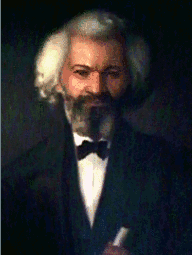
Douglass 188_
|
1878. Douglass
purchases "Cedar Hill" a 9-acre estate in the Anacostia
section of Washington, DC.
1881. Frederick
Douglass is appointed Recorder of Deeds for the District of Columbia.
He publishes a third autobiography: Life and Times of Frederick
Douglass.
1882a. Florence
Sprague and Viola VanBuren where the first Black teachers in
the Rochester School District. (note: it appears not to be true
that Florence is daughter of Rosetta Douglass Sprague, see 1863)
1882b. Anna
Douglass, died after a long illness.
1883. Distinguished
Men of New York
|
1884a. Resigns
as Recorder of Deeds for the District of Columbia.
1884b. Frederick Douglass marries
his secretary Helen Pitts, a white woman from Honeoye New York
(not 20 miles distant Honeoye Falls), who was nearly 20 years
younger than he. Both families recoiled; hers stopped speaking
to her; his was bruised for they felt his marriage was a repudiation
of their mother.
|
Hellen Pitts was a graduate of Mount Holyoke
Seminary, and daughter of Gideon Pitts, Jr., an abolitionist
colleague and friend of Douglass'. Gideon's home was a station
on the Underground Railroad.. While living in Washington, D.C.
before her marriage, Helen had worked on a radical feminist publication
called the Alpha.
Helen is a direct descendent of John and Priscilla
Alden and a cousin to Presidents John and John Q. Adams.
As a result, the marriage of a Mayflower Daughter to a former
slave was yet another source of outrage to those who opposed
the inter-racial marriage with Douglass. It was Pitts' race,
and not her age upset both the black and the white communities.
Douglass' response was, My first wife was the color of my
mother, my second is the color of my father.
Pitts, nevertheless, would prove to be most
influential at establishing the Frederick Douglass home and maintaining
the legacy of Douglass after his death..
|

Helen Pitts Douglass
|
1884c. Frederick
Douglass' lover of 26 years, Ottilie
Assing commits suicide (see 1856 above).
1886. 1986-87
Frederick and Helen travel to England, France, Italy, Egypt and
Greece in 1886-87.
1888. Appointed
Consul General to Haiti by President Benjamin Harrison
1889. Appointed
Charge d'Affaires for Santo Domingo as well as Minister Resident
to Haiti.
1891. Resigns
as Minister to Haiti.
1892. Below -
President Benjamin Harrison attends ceremony at Kodak Park with
Frederick Douglass, Mayor Hiram Edgerton and Civil War veterans.
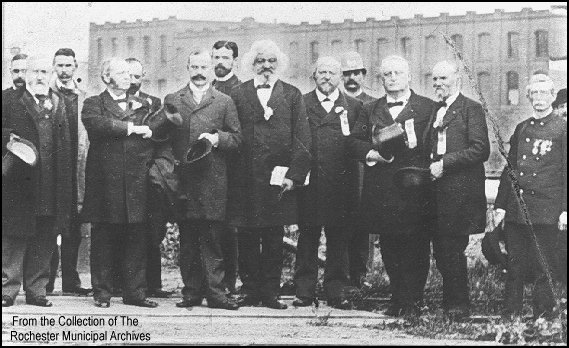
1893. Announces
plans to establish Freedom Manufacturing Co., a textile manufacturing
firm, on a site near Norfolk, Virginia, where he hopes to employ
300 blacks. The scheme proves to be a sham by unscrupulous promoters
using his name and prestige.
1895. On February
20, Frederick Douglass at Cedar Hill, Anacostia, after attending
a women's rights meeting, was struck by a massive heart attack
and died at the age of 77. As news of Douglass's death spread
throughout the country, crowds gathered at the Washington church
where he lay in state to pay their respects. Black public schools
closed for the day, and parents took their children for a last
look at the famed leader. His wife and children accompanied his
body back to Rochester, where he was laid to rest. Helen works
to preserve the Douglass home in memory of Frederick.
| The Frederick Douglass Home. At the request of Helen Pitts Douglass, Congress
chartered the Frederick Douglass Memorial and Historical Association,
to whom Mrs. Douglass bequeathed the house. Joining with the
National Association of Colored Women's Clubs, the association
opened the house to visitors in 1916. The property was added
to the National Park system on September 5, 1962 and was designated
a National Historic Site in 1988. The Frederick Douglass National
Historic Site is located at 1411 W Street, SE in Washington,
D. C. and it is opened to the public. |

|
1896. Rosetta
Douglass Sprague was a founding member of the National Association
of Colored Women.
1898. The first
monument to a black man, Frederick
Douglass (also see 1847), was
established in Rochester.
1910. While serving
as president of the Frederick Douglass Memorial Association, Mary
Talbert was responsible for the restoration of the Frederick Douglass
Home in Anacostia, Maryland. She also served as a delegate to
the International Council of Women in Norway, and lectured internationally
internationally on race relations and women's rights. For more
on Talbert click Talbert.
Children of Frederick Douglass:
Rosetta, Lewis Henry, Frederick, Jr., Charles Resmond, Annie
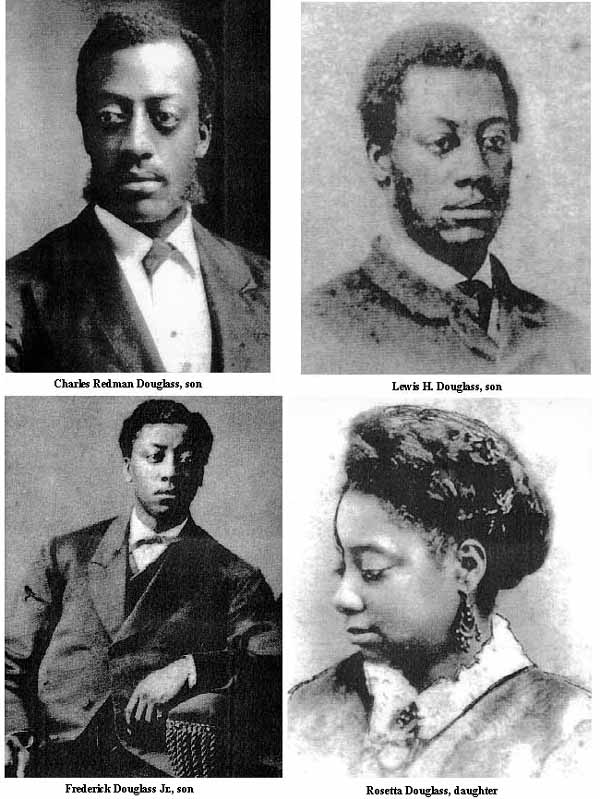
Mary Louise was the daughter of Charles Resmond
Douglass. Her siblings were Charles Frederick, Joseph Henry, Annie
Elizabeth, Julia Ada, Edward and Haley George.
Some references:
- Douglass, Frederick. Life and Times of Frederick Douglass:
His Early Life as a Slave, His Escape From Bondage, and His Complete
History Written by Himself. New York: Collier Books, 1962.
- Douglass, Frederick. Narrative of the Life of Frederick
Douglass an American Slave, Written by Himself. Ed. Benjamin
Quarles. Cambridge, Mass.: Harvard UP, 1960.
- Douglass, Helen Pitts. In Memoriam: Frederick Douglass.
Freeport, N.Y.: Books for Libraries Press, 1971.
- Diedrich, Maria. Love across Color Lines: Ottilie Assing
and Frederick Douglass. Hill and Wang, 1999, 480 pp.
$35.00, isbn 0-8090-1613-3.)
- Douglass, Frederick. The Heroic Slave. (published
in Autographs for Freedom, edited Julia Griffiths [Cleveland:
John P. Jewett & Company, 1853]
- May 2003 letters from Jean Czerkas <JFCZERKAS@msn.com>.
Florence Sprague is not a child of Rosetta Douglass. Rosetta,
her husband Nathan, three of their daughters and only son are
interred in historic Mt. Hope Cemetery in Rochester, New York.
There children are:
Alice Louisa; Annie Rosine; Harriet Bailey; Estelle Irene; Fredericka
Douglass; Herbert Douglass; Rosebelle Mary.
Other sites:
Frederick Douglass home.
Frederick Douglass Museum and Cultural Center.
back to African
American History of Western New York
CONTACT US










